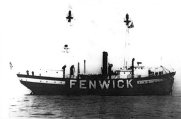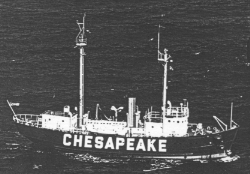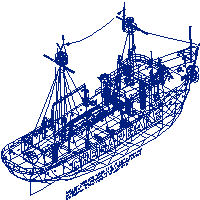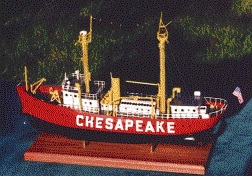

These days, there are many models on the market. The fact of the matter is that a very small portion of what is sold now are actually scratch-built. Scratch-built means that every part of the model is made by it's builder. It is not made from a kit. All of the parts of the model, no matter how small, are made by the modeler himself. Of the many models on the market today, a large percentage are made using kits and commercially made parts, while another large percentage are made in factory settings, using duplicating equipment, the finer work being done along assembly lines. Those made from kits will have a wide range of quality, depending on the skill and labor of the builder. The duplicated boats tend to look nice from a distance, but when you get close, it is seen that they are generally made to very poor standards of fit and finish and are usually not accurate reproductions of the original boats. If you see low-priced models of the "CHESAPEAKE", which have become common in recent times, compare them to the photos on this page and you will understand my point. You can see that scratch-building is more labor-intensive than either of the above mentioned ways of model-building. I make my own plans for all of my models. This is not done in assembling kits, which provide the maker with plans, pre-cut parts, hardware and recommendations for painting and finishing.
The fact that scratch-building can be a more difficult technique, in and of itself, is certainly not a reason for you to buy such a model. The end product is what is important. The first significant difference is that it creates options: there are no predetermined plans or limitations on what can be created. With kits, what boat is made is limited by what kits are available. Factory built models are complete already. If you have a type of boat, a style of model, size, a certain budget, and/or any other reasons for customization, scratch-building provides the greatest number of options right from the start. When I build a custom model, I am building your boat. The hardware on it is based on the hardware that is on your boat. The logo on the stern is the logo from your boat, etc. Scratch-building, like sculpting, is a fine art. The methods involved in making such models include: mathematics, drafting, woodworking, metalworking, painting, jewelry making, graphic arts, and design arts. Many people these days are also realizing the value of scratch-built models as true collectibles. I have several customers who buy my models each year. Most importantly, I build quality models. Because I am in control of every aspect from start to finish, quality is assured.
Here is a brief synopsis of the process of building a custom model...
There are many ways to break model making down, but I have found this a helpful way to view the process:
Stage 1. Research |  |
The research stage is one that involves deciding what boat is being modeled, what style of model will be made, what information will be necessary to make proper plans and getting that information. In some cases, information is not readily available and extra research may be necessary.
There are many ways to style a model. It may be "by eye", which is to say that the priority is not so much on precision insomuch as it is on capturing a boat's artistic beauty. Emphasis could also be on extremely accurate representation of the boats "lines", with little or no hardware, because such items would cause visual interference. Some models serve as platforms for the display of mechanical parts that a boat has. A model can also be designed to include every conceivable detail,interior and exterior, with working parts, actual lighting, fully detailed engines, and every bung, rivet and screw represented.
The more detailed and truly accurate a model is to be, the more necessary good information becomes. The style of model being made often dictates the amount of research needed. The information needed for a "by eye" model may only be a few photographs or even sketches. For highly detailed models, every detail must be understood in terms of what it looks like, how it was made, what it is made of, and what its purpose is. Optimal information includes manufacturers plans or line drawings, access to the actual boat, many photographs and various historical information. You may not have all of this material. Over time I have found many excellent resources, including libraries, museums, the internet, manufacturers and trade magazines, in which I can get additional information.
Stage 2. Planning |  |
Stage 3. Construction |  |
This is the point at which all of the above effort becomes physical reality. My models can be "lift-built", "plank on frame", created from fiberglass, or from metal. Some models will be built over a "mold" such as boats with many stringers and few large frames such as canoes. The majority of my models are lift-built, which is to say that the initial "core" of the boat is created from many intricately designed layers and carved. These layers may run with waterlines or buttock lines. Bi-symmetrical carving of these layers requires practice, special techniques, and a great deal of patience. Lift-building is an especially good technique for representing boats of wood, fiberglass or metal. In all cases, regardless of the complexity of the model, certain operations are required. These include selecting materials, rough-cutting, sub-assembly, finer cutting, carving and assembly, painting between assembly stages, various glue-ups, final painting, making hardware and other small parts and attaching them to the model, creating and adding graphics, final finishing, assigning a serial number and signing. Depending upon the model, additional techniques would include rigging, upholstering, steam-bending, jewelry-making, ceramics, glass and plastic work.
I use a simple pricing system. It is strictly based on labor. I set a price at the beginning of the job after my customer and I have decided on the attributes of the model. I require 1/3rd of the price down and the remaining 2/3rds upon completion. I do not change the price unless the customer changes specifications. Applicable taxes and Shipping are not included.
Home |
Show Schedule |
Pictures, Descriptions, Items In Stock |
More about me... |
How to order |
Links To Other Sites |